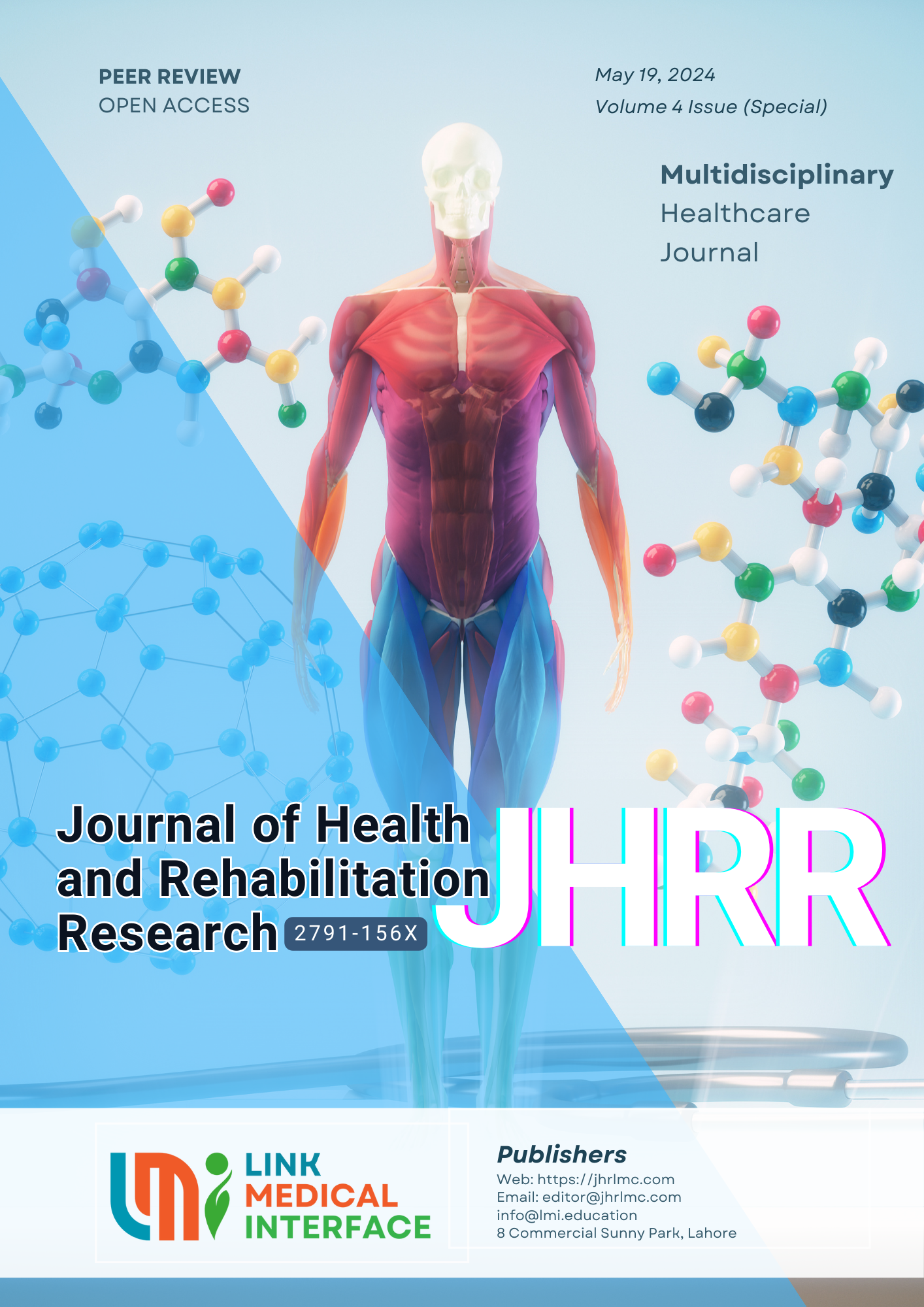Effect of Maitland Mobilization with and without Spencer Muscle Energy Techniques in Treatment of Frozen Shoulder
DOI:
https://doi.org/10.61919/jhrr.v4iICIC1.1099Keywords:
Frozen Shoulder, Adhesive Capsulitis, Muscle Energy TechniquesAbstract
Background: Frozen Shoulder, or Adhesive Capsulitis, is an inflammatory condition marked by shoulder stiffness, pain, and significant loss of passive range of motion. The condition predominantly affects individuals between 40 and 60 years of age, with a higher prevalence in women. Various treatment approaches have been explored, yet no single approach has been universally accepted as standard. Physiotherapeutic interventions, such as Maitland Mobilization and Muscle Energy Techniques (METs), have shown promise in managing this condition.
Objective: To compare the effectiveness of Maitland Mobilization with and without Spencer Muscle Energy Techniques in treating frozen shoulder.
Methods: This randomized controlled trial was conducted over four months at the physiotherapy departments of Allied Hospital and DHQ Hospital in Faisalabad. Forty patients with unilateral frozen shoulder, aged 40 to 60 years, were randomly assigned to two groups: Group A (Maitland Mobilization with Spencer METs) and Group B (Maitland Mobilization only). Each group received three treatment sessions per week for six weeks. Outcome measures included the Shoulder Pain and Disability Index (SPADI), Numeric Pain Rating Scale (NPRS), and goniometric assessment of shoulder range of motion (ROM). Data were collected at baseline and post-intervention. Statistical analysis was performed using SPSS version 25, with independent sample t-tests for between-group comparisons and paired sample t-tests for within-group differences.
Results: The Group A showed a significant improvement in NPRS scores from 5.95 ± 1.96 to 2.25 ± 0.72 (p = 0.001), SPADI scores from 86.20 ± 9.37 to 45.00 ± 9.54 (p = 0.014), and IADL scores from 18.55 ± 5.46 to 8.55 ± 4.83 (p = 0.011). Group B also showed improvements, with NPRS scores from 5.40 ± 1.35 to 3.55 ± 1.28 (p = 0.001), SPADI scores from 81.55 ± 12.84 to 57.20 ± 18.93 (p = 0.014), and IADL scores from 18.75 ± 4.63 to 13.65 ± 6.94 (p = 0.011). Group A demonstrated superior outcomes in shoulder flexion, extension, abduction, adduction, internal rotation, and external rotation (all p < 0.05).
Conclusion: Both Maitland Mobilization and Spencer METs effectively reduced pain and improved ROM and functional capacity in patients with frozen shoulder. However, the combined treatment of Maitland Mobilization with Spencer METs was more effective than Maitland Mobilization alone. These findings suggest that integrating both techniques into clinical practice could enhance treatment outcomes for patients with adhesive capsulitis.
Keywords: Frozen Shoulder, Adhesive Capsulitis, Maitland Mobilization, Muscle Energy Techniques, Spencer Technique, Shoulder Pain, Range of Motion, Physiotherapy, Rehabilitation Management
Downloads
References
Dias R, Cutts S, Massoud S. Frozen Shoulder. Available from: https://www.ncbi.nlm.nih.gov/books/NBK532955/
Maitland G. Treatment of the Glenohumeral Joint by Passive Movement. Physiotherapy. 1983;69(1):3-7.
Gupta S, Jaiswal P, Chhabra D. A Comparative Study Between Post-Isometric Relaxation and Isometric Exercises in Non-Specific Neck Pain. J Exerc Sci Physio. 2008;4(2):88-94.
Rajadurai V. The Effect of Muscle Energy Technique on Temporomandibular Joint Dysfunction: A Randomized Clinical Trial. Asian J Sci Res. 2011;4(1):71-77.
Kumar S, Kumar S, Joshi D, Saibaba B, Das S, Sharma S. Efficacy of Maitland Mobilization and Exercises in Idiopathic Shoulder Adhesive Capsulitis: A Randomized Controlled Trial. J Rehabil Med. 2012;44(8):665-9.
Curcio J. Muscle Energy Technique for Shoulder Dysfunction: A Review of Spencer Technique. J Bodyw Mov Ther. 2017;21(3):605-12.
Khan Z, Akmal F, Asif M, Khan Z, Alam F, Khalid U, et al. Comparison of Effectiveness of Maitland’s Mobilizations at End-Range Versus Within Pain-Free Joint Range of Movement in Treatment of Patients with Frozen Shoulder RCT. Br J Multidiscip Adv Stud. 2023;4(5):100-26.
Fabiano J, Schwartz A, Mace T, Seaman E. Adhesive Capsulitis. Available from: https://www.ncbi.nlm.nih.gov/books/NBK532955/
Iqbal M, Riaz H, Ghous M, Masood K. Comparison of Spencer Muscle Energy Technique and Passive Stretching in Adhesive Capsulitis: A Single Blind Randomized Control Trial. J Pak Med Assoc. 2020;70(12):2113-8.
Ali M, Hashim M, Waseem I, Manzoor S, Ahmad I. Comparison of Maitland Mobilization and Muscle Energy Technique on Pain, Range of Motion and Functions in Adhesive Capsulitis. Pak BioMed J. 2022;5(3):129-33.
Almureef SS, Ali WM, Shamsi S, Al Zahrani MB. Effectiveness of Mobilization with Conventional Physiotherapy in Frozen Shoulder: A Systematic Review. Int J Recent Innov Med Clin Res. 2020;2(4):22-9.
Contractor ES, Agnihotri DS, Patel RM. Effect of Spencer Muscle Energy Technique on Pain and Functional Disability in Cases of Adhesive Capsulitis of Shoulder Joint. IAIM. 2016;3(8):126-31.
Sathe S, Khurana SK, Damke U, Agrawal PV. To Compare the Effects of Maitland Mobilization with Conventional Physiotherapy in Adhesive Capsulitis. Int J Curr Res Rev. 2020;2(4):22-9.
Jivani RR, Hingarajia DN. Effect of Spencer Muscle Energy Technique Versus Maitland’s Mobilization Technique on Pain, ROM and Disability in Patients with Frozen Shoulder: A Comparative Study. Int J Physiother Res. 2021;9(4):3928-36.
Al Shehri A, Almureef SS, Khan S, Shamsi S. Efficacy of Maitland Mobilization in Frozen Shoulder. Eur J Biomed Pharm Sci. 2018;5(12):22-7.
Gill MA, Gohel BP, Singal SK. Effect of Muscle Energy Technique on Pain and Function in Adhesive Capsulitis–An Interventional Study. Int J Health Sci Res. 2018;8(3):133-7.
Gasibat Q, Rafieda AE, Alajnaf RB, Elgallai AA, Elzidani HA, Sowaid EM. Spencer Muscle Energy Technique Versus Conventional Treatment in Frozen Shoulder: A Randomized Controlled Trial. Int J Kinesiol Sports Sci. 2022;10(3):28-36.
Kotagiri S, Mathur N, Balakavi G, Songa AK. The Effectiveness of Muscle Energy Technique and Mobilization to Improve the Shoulder Range of Motion in Frozen Shoulder. Int Arch Integr Med. 2019;6(10):126-31.
Downloads
Published
How to Cite
Issue
Section
License
Copyright (c) 2024 Muhammad Abbas, Muhammad Umar Hassnain, Saqib Bilal, Khushbakht Sohail, Muhammad Amir Hussain, Abdul Basit Zeeshan Kundi

This work is licensed under a Creative Commons Attribution 4.0 International License.
Public Licensing Terms
This work is licensed under the Creative Commons Attribution 4.0 International License (CC BY 4.0). Under this license:
- You are free to share (copy and redistribute the material in any medium or format) and adapt (remix, transform, and build upon the material) for any purpose, including commercial use.
- Attribution must be given to the original author(s) and source in a manner that is reasonable and does not imply endorsement.
- No additional restrictions may be applied that conflict with the terms of this license.
For more details, visit: https://creativecommons.org/licenses/by/4.0/.






